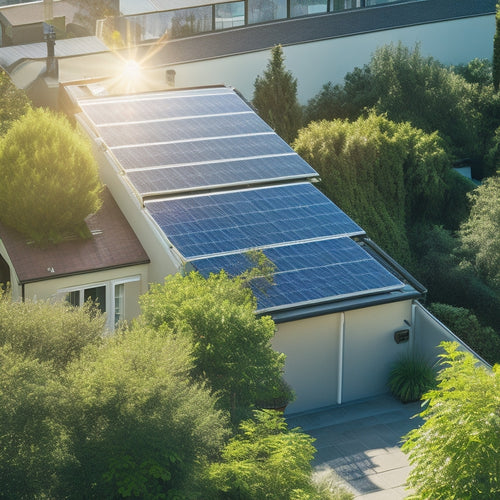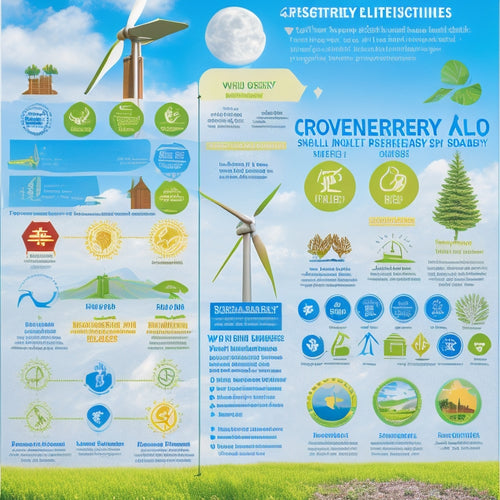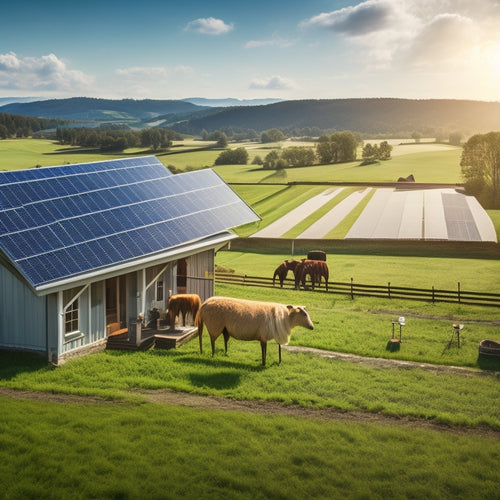
Irrigation Systems Powered by Renewable Energy Solutions
Share
By integrating renewable energy solutions into your irrigation system, you can greatly reduce your carbon footprint while enjoying lower operating costs and enhanced system performance. Renewable energy solutions like solar and wind power can power your irrigation system, reducing reliance on fossil fuels and mitigating climate change. You'll benefit from reduced energy costs, on-site electricity generation, and decentralized energy supply. As you explore renewable energy options for your irrigation system, you'll discover the advantages of energy independence, cost savings, and environmental sustainability. You're just starting to scratch the surface of the benefits – there's more to uncover ahead.
Key Takeaways
• Renewable energy solutions reduce carbon emissions and lower operating costs for irrigation systems, enhancing environmental sustainability.
• On-site electricity generation and decentralized energy supply ensure stable power for irrigation systems, minimizing reliance on fossil fuels.
• Energy storage systems integrated with renewable energy solutions provide a stable power supply, optimizing irrigation system performance and minimizing energy costs.
• Regular maintenance tasks, such as cleaning solar panels and monitoring system performance, are essential to ensure peak system performance and longevity.
• Government incentives, including tax credits and grant funding, are available to support the adoption of renewable energy-powered irrigation systems.
Benefits of Solar Power
When you consider renewable energy solutions for powering irrigation systems, harnessing solar power offers numerous advantages, including reduced carbon emissions and lower operating costs.
By investing in solar farms, you can generate electricity on-site, reducing reliance on the grid and minimizing transmission losses. This decentralized approach enables you to have greater control over your energy supply.
Additionally, integrating energy storage systems with your solar farm allows you to store excess energy generated during the day for use during periods of low sunlight or at night. This hybrid system guarantees a stable and reliable power supply for your irrigation system, reducing your operating expenses and environmental footprint.
With solar power, you can optimize your irrigation system's performance while minimizing your energy costs.
Environmental Impact Reduction
As you shift to renewable energy-powered irrigation systems, you'll greatly reduce your carbon footprint, resulting in a cleaner environment.
By leveraging sustainable water management practices, you'll also minimize the ecological impact of your irrigation methods.
Carbon Footprint Reduction
By integrating renewable energy sources into irrigation systems, you can greatly reduce your carbon footprint, minimizing the environmental impact of farming practices. This reduction in carbon emissions is important for mitigating climate change.
Implementing eco-friendly practices in agriculture is necessary for sustainable development. Climate accounting plays an essential role in tracking and managing greenhouse gas emissions.
By moving to renewable energy-powered irrigation systems, you can notably decrease your carbon footprint, contributing to a more sustainable future. This shift not only benefits the environment but also enhances your reputation as a responsible farmer.
Sustainable Water Management
Your irrigation system's water management practices have a significant impact on the environment and adopting sustainable methods is essential to reduce the ecological footprint of your farming operations.
By implementing water conservation techniques, such as drip irrigation and soil moisture monitoring, you can reduce water waste and minimize the strain on this precious resource.
Additionally, selecting drought-tolerant crops or those with low water requirements can further reduce your water usage. Crop selection can also be optimized based on seasonal water availability, ensuring that your irrigation system is working in harmony with nature.
Cost Savings Analysis
When evaluating the financial benefits of renewable energy-powered irrigation, you'll want to assess the return on investment (ROI) and conduct thorough financial modeling. This will help you understand the long-term cost savings and payback period of your investment.
By analyzing your energy consumption and expenditures, you can identify areas where renewable energy solutions can make the most impact. With a clear understanding of your energy usage and expenditures, you can optimize your irrigation system's performance and maximize cost savings.
System Design and Installation
Now that you've analyzed the cost savings of renewable energy-powered irrigation systems, it's time to design and install a system that meets your specific needs.
You'll need to evaluate various system configuration options, energy harvesting methods, and component selection criteria to guarantee efficient and effective operation.
System Configuration Options
When designing an irrigation system powered by renewable energy, several system configuration options must be carefully considered to ensure peak performance, efficiency, and cost-effectiveness. You'll need to determine the best pump station location, taking into account factors such as pipeline routing, water pressure, and energy consumption. The system's configuration will also impact its overall energy efficiency and reliability.
| System Configuration Option | Description |
|---|---|
| Centralized Pump Station | Single, large pump station serving the entire irrigation system |
| Decentralized Pump Stations | Multiple, smaller pump stations distributed throughout the system |
| Hybrid Pumping System | Combination of centralized and decentralized pump stations |
| Solar-Powered Pumping | Solar panels directly powering the pump station, reducing energy storage needs |
Energy Harvesting Methods
How will you harness the power of renewable energy to fuel your irrigation system, and what design and installation considerations will you need to take into account to maximize energy harvesting?
When designing your energy harvesting system, you'll need to ponder the unique challenges of your irrigation system's power requirements.
You'll want to explore the following energy harvesting methods:
-
Photovoltaic Systems: Convert sunlight into electricity to power your irrigation system.
-
Wind Turbines: Harness wind energy to generate electricity.
-
Thermal Dynamics: Leverage temperature differences to produce electricity, ideal for systems with access to heat sources.
- Vibration Energy: Capture kinetic energy from machinery or environmental vibrations to generate power.
Component Selection Criteria
To guarantee peak performance and efficiency, you must carefully select components that meet the specific demands of your renewable energy-powered irrigation system. This involves considering factors such as power output, energy storage, and system compatibility.
When selecting components, you should prioritize critical reliability standards to ensure that each part can withstand the rigors of continuous operation. Material durability is also vital, as it directly impacts the system's lifespan.
You should establish clear performance metrics to evaluate component quality and conduct thorough compatibility testing to ensure seamless integration. Implementing a robust quality assurance process and managing your supply chain effectively will help you achieve peak system performance.
Energy Independence Advantage
By harnessing renewable energy to power irrigation systems, you gain the significant advantage of energy independence, reducing reliance on fossil fuels and mitigating the risks associated with price volatility. This independence enables you to take control of your energy needs, making your irrigation system more resilient and reliable.
Some key benefits of energy independence include:
-
Rural empowerment: Renewable energy-powered irrigation systems can stimulate local economies and promote rural development.
-
Community resilience: Energy independence enhances community resilience by reducing reliance on external energy sources.
-
Predictable energy costs: With renewable energy, you can better plan and manage your energy expenses.
- Environmental sustainability: Renewable energy-powered irrigation systems reduce greenhouse gas emissions, contributing to a more sustainable future.
Irrigation System Integration
You'll need to carefully integrate your renewable energy system with your existing irrigation infrastructure to maximize efficiency and optimize performance. This involves synchronizing your crop monitoring data with farm automation systems to guarantee precise water application.
Conduct thorough soil analysis to determine the best water scheduling and pipe sizing for your specific crop requirements. Create detailed field maps to guide irrigation scheduling and guarantee accurate flow measurement.
Maintenance and Repair Needs
Regular maintenance checks of your renewable energy-powered irrigation system are crucial to prevent unexpected downtime and costly repairs. By taking proactive measures, you can guarantee that your system operates efficiently and effectively.
Here are some key maintenance tasks to prioritize:
- Inspect and clean solar panels and wind turbines regularly to maintain peak energy generation.
- Check and replace worn-out or damaged components, such as pumps and valves, to avoid system failures.
- Monitor system performance and energy output to identify potential issues early on.
- Perform routine software updates to confirm that your system stays optimized and secure.
Government Incentives Available
In addition to optimizing your renewable energy-powered irrigation system's performance, you can also benefit from various government incentives that promote the adoption of sustainable energy solutions. These incentives can help offset the initial investment costs and increase the return on investment for your renewable energy-powered irrigation system.
Here's a summary of available government incentives:
| Incentive Type | Description | Eligibility |
|---|---|---|
| Tax Credits | 30% of total project cost | Commercial and agricultural projects |
| Grant Funding | Up to $500,000 per project | Rural and agricultural projects |
| Policy Updates | Net metering laws and renewable portfolio standards | Varies by state and region |
Future of Renewable Energy
As the world continues to shift towards a low-carbon economy, the future of renewable energy holds immense promise, with the International Energy Agency predicting a 65% increase in global renewable energy capacity by 2026.
You'll be excited to know that this growth is driven by various factors. Here are a few key ones:
-
Global cooperation: International agreements and collaborations will facilitate the sharing of knowledge, technology, and best practices.
-
Energy storage: Advancements in energy storage systems will enable efficient and reliable power supply.
-
Tech advancements: Innovations in renewable energy technologies will improve efficiency and reduce costs.
- Policy reforms: Governments will implement supportive policies and regulations to encourage the adoption of renewable energy sources.
These developments will be vital in shaping the future of renewable energy.
Frequently Asked Questions
Can Renewable Energy Power Center Pivot Irrigation Systems?
As you consider the possibility, let's delve into the heart of the matter: yes, you can energize center pivot irrigation systems with renewable energy, enabling water conservation and energy efficiency, and giving you precise control over your agricultural operations.
Are Energy Storage Systems Required for Off-Grid Irrigation?
'You'll need to evaluate if energy storage systems are required for off-grid irrigation by analyzing your energy demands and renewable energy output, ensuring proper battery sizing for reliable grid independence and uninterrupted irrigation operations.'
How Does Weather Affect the Performance of Solar Panels?
As you navigate the world of solar energy, you'll find that weather wields significant influence, with cloudy skies reducing panel efficiency by up to 25%. Temperature coefficients also play an important role, affecting energy output by ±0.5% per degree Celsius.
Can I Use Wind Energy to Power My Irrigation System?
You can harness wind energy to power your irrigation system by installing a wind turbine, which converts wind kinetic energy into electrical energy through energy harvesting, providing a sustainable and reliable power source.
Are Renewable Energy-Powered Irrigation Systems Scalable?
You're wondering if scalable renewable energy-powered irrigation systems are a myth or reality? Think again! With land ownership and water conservation in mind, you can design a system that's not only eco-friendly but also tailored to your specific needs.
Related Posts
-

How Solar Panels Reduce Electricity Bills
Solar panels can drastically cut your electricity bills by utilizing sunlight to generate your own energy. This decre...
-

Renewable Energy Certifications for Businesses
Renewable energy certifications are essential for your business, showcasing your commitment to sustainability and enh...
-

Solar Power Systems for Rural Properties
Solar power systems offer a reliable and efficient energy solution for rural properties, allowing you to gain energy ...


